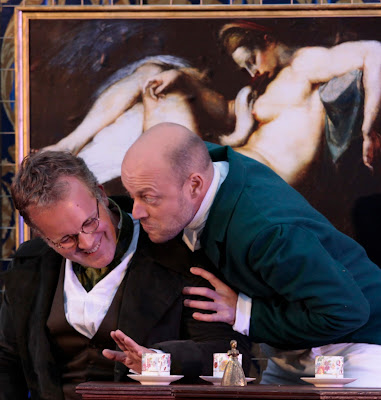 |
| Saleri: La scuola de' gelosi - Matthew Sprange, Rhiannon Llewellyn, Alessandro Fisher, Nathalie Chalkey, Thomas Herford - Bampton Classical Opera (Photo Anthony Hall/Bampton Classical Opera) |
Reviewed by Robert Hugill on Sep 12 2017 Star rating:
Popular in its day, Salieri's comedy might stretch the charm somewhat but it provides important background for Mozart's mature comedies
 |
| Matthew Sprange, Thomas Herford (Photo Anthony Hall/Bampton Classical Opera) |
Salieri wrote La scuola de' gelosi for the Teatro San Moise in Venice in 1778, the librettist was Caterino Mazzola. Mazzola is perhaps best known as the adapter of Metastasio's libretto for Mozart's La Clemenza di Tito, but Mazzola was also a friend of Lorenzo da Ponte and it was Mazzola who provided Da Ponte with a letter of recommendation to Salieri when Da Ponte pitched up in Vienna. With Da Ponte's help, Salieri revised La scuola de' gelosi for Vienna in 1783, when its performance launched the re-established Italian opera company. For this performance the role of the Countess was sung by Nancy Storace, who would go on to create the role of Susanna in Mozart's Le nozze di Figaro.
La scuola de' gelosi seems to have been one of Salieri's most popular operas, with at least fifty productions across Europe during the first 20 years of its existence. In Vienna, Salieri and Da Ponte seem to have planned a follow up, La scuola degli amanti. Da Ponte wrote the libretto and Salieri sketched some music. But Salieri abandoned the project, and Da Ponte passed the libretto to Mozart where it became Cosi fan tutte!
 |
| Matthew Sprange - (Photo Anthony Hall/Bampton Classical Opera) |
Blasio is inordinately jealous, and the opera opens with him planning to go out on business and locking his wife Ernestina up. The Count is a philanderer with a fondness for the wives of jealous husbands, and he has his eye on Ernestina, to the distress of the Countess who loves her husband. The Lieutenant rather aids and abets things, stirring things up, and after a series of rather farcical situations the opera is resolved with the two couples agreeing to try again.
It is a charming piece, with engaging and interesting music. Salieri's use of ensembles was particularly notable, including two trios and a quintet all of which had an element of imaginative dramatic propulsion to them. And the two act finales were both notable, multi-sectional and very much driven by the action with the first act finale including an ensemble of confusion which was almost Rossinian.
 |
| Nathalie Chalkley, Alessandro Fisher (Photo Anthony Hall/Bampton Classical Opera) |
I had heard good reports of the performances in Bampton where the comedy seemed to really fizz, but the transfer to St John's Smith Square seemed to have taken a bit of the sparkle out of the production. Perhaps having orchestra and conductor Anthony Kraus (who also played the continuo) behind the scenery, forced to communicate with the singers via monitors, made the speeds a little too safe. Whatever the cause, despite admirable performances the long first act (75 minutes) did rather sag. It did not help that in the tricky St John's acoustic, the diction was a bit patchy so that you had to strain to hear the dialogue (sung in Gilly French and Jeremy Gray's translation).
But individual performances were strong, and there were some notable moments particularly in the arias and ensembles. Alessandro Fisher made a nicely bumptious Count, completely charming in his infidelity, whilst Rhiannon Llewellyn was a poignant Countess with her final accompanied recitative and aria one of the opera's strongest moments. Matthew Sprange made the jealous Blasio highly personable, whilst Nathalie Chalkley (who had been ill) was a nervous, put-upon spouse who discovered her own metier when she really does embark on a liaison with the Count (though they only get as far as shopping!). Thomas Herford was all charm as the ubiquitous Lieutenant, whose manipulation of the two couples seemed to arise out of sheer delight at interfering. The two servants, Carlotta (Kate Howden) and Lumaca (Samuel Pantcheff) were no mere cyphers and both Howden and Pantcheff succeeded in giving them real personality.
The orchestra under Anthony Kraus bubbled away nicely in Salieri's lively score, with some lovely wind playing adding colour to the proceedings.
Bampton Classical Opera play a valuable role in giving us the opportunity to hear rarely performed 18th century operas, and their espousal of Salieri shows the rich background from which Mozart's mature operas sprung.
Elsewhere on this blog:
- The Art of Dancing: New concertante works for trumpet, piano and strings - CD review
- From curiosity to charm: A portrait of Felicien David - CD review
- Double vision: Two views of Sondheim's Follies at the National Theatre - theatre review
- Last of the romantics: Sholto Kynoch introduces the 2017 Oxford Lieder Festival - interview
- Bold romanticism: Howard Blake's Piano Concerto and Diversions for cello and orchestra - concert review
- Palestrina and Poulenc: The Sixteen's Choral Pilgrimage - Concert review
- Delight and imagination: Buxtehude trio sonatas from Arcangelo - CD review
- Neglected Stanford: Sam Haywood in Stanford's preludes at Rhinegold Live - Concert review
- Holy chants and apocalyptic mayhem: I Musicanti at St John's Smith Square - concert review
- Neglected Schubert: Daniel Behle in operatic arias - CD review
- An evening of theatrical magic: British Youth Opera in Judith Weir's The Vanishing Bridegroom - opera review
- Glass & more: The Baltic Sea Philharmonic's debut at the Elbphilharmonie in Hamburg - concert review
- Home



%20and%20kids.jpg)
.webp)



.jpg)


No comments:
Post a Comment